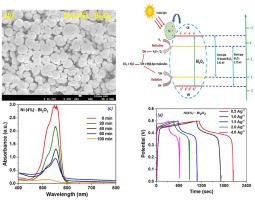当前位置:
X-MOL 学术
›
Mater. Chem. Phys.
›
论文详情
Our official English website, www.x-mol.net, welcomes your feedback! (Note: you will need to create a separate account there.)
Enhancement in photocatalytic and electrochemical performance of hydrothermally synthesized β-Bi2O3 via Ni incorporation
Materials Chemistry and Physics ( IF 4.6 ) Pub Date : 2024-04-01 , DOI: 10.1016/j.matchemphys.2024.129275 M.A. Majeed Khan , Kamaldeep Punia , Anees A. Ansari , Maqusood Ahamed , Sushil Kumar , Abu ul Hassan S. Rana
Materials Chemistry and Physics ( IF 4.6 ) Pub Date : 2024-04-01 , DOI: 10.1016/j.matchemphys.2024.129275 M.A. Majeed Khan , Kamaldeep Punia , Anees A. Ansari , Maqusood Ahamed , Sushil Kumar , Abu ul Hassan S. Rana

|
β-BiO and Ni-incorporated β-BiO nanoparticles with different Ni incorporating amounts (0, 2, and 4 at. wt. %) were successfully synthesized through a viable hydrothermal process. As-synthesized nanoparticles were analyzed by complementary analytical tools such as X-ray diffraction (XRD), field emission scanning electron microscopy (FESEM), high resolution transmission electron microscopy (HRTEM), X-ray photoelectron spectroscopy (XPS), energy dispersive X-ray spectroscopy (EDS), UV–visible spectroscopy (UV–Vis), and photoluminescence spectroscopy (PL) for structural, microstructural, compositional, and spectral properties. The photocatalytic performance of synthesized nanoparticles was assessed by subjecting them to visible light irradiation and monitoring the decomposition of rhodamine-B dye. The findings demonstrated that the inclusion of Ni(4%) in β-BiO nanoparticles significantly enhanced its photocatalytic activity compared to pristine β-BiO which is desirable for environmental remediation. This improvement may be caused by increased generation of electron-hole (e-h) pairs, reduced recombination rate of these pairs, enhanced absorption of visible light, and a decreased band gap energy. To evaluate the specific capacitance characteristics of synthesized electrode materials, cyclic voltammetry, galvanostatic charge-discharge, and electrochemical impedance analyses were conducted. The super capacitance activities of prepared electrode materials were observed in the order of BiO < Ni(2%)-BiO < Ni(4%)-BiO. Notably, Ni(4%)-BiO nanocomposite exhibited higher supercapacitance, which can be attributed to the effective role of appropriate nickel incorporation in BiO. These results suggested that the incorporation of Ni(4%) into β-BiO to form a nanocomposite showed greater capability as an effective electrode material for advanced energy storage devices, especially supercapacitors.
中文翻译:

通过 Ni 掺入增强水热合成 β-Bi2O3 的光催化和电化学性能
通过可行的水热工艺成功合成了不同 Ni 掺入量(0、2 和 4 at. wt.%)的 β-Bi2O 和掺 Ni β-Bi2O 纳米颗粒。通过补充分析工具对合成的纳米粒子进行分析,例如 X 射线衍射 (XRD)、场发射扫描电子显微镜 (FESEM)、高分辨率透射电子显微镜 (HRTEM)、X 射线光电子能谱 (XPS)、能量色散 X用于结构、微观结构、成分和光谱特性的射线光谱 (EDS)、紫外-可见光谱 (UV-Vis) 和光致发光光谱 (PL)。通过将合成的纳米颗粒置于可见光照射下并监测罗丹明-B 染料的分解来评估其光催化性能。研究结果表明,与原始β-Bi2O纳米粒子相比,在β-Bi2O纳米粒子中添加Ni(4%)显着增强了其光催化活性,这对于环境修复是理想的。这种改进可能是由于电子-空穴(eh)对的产生增加、这些对的复合率降低、可见光吸收增强以及带隙能量降低所致。为了评估合成电极材料的比电容特性,进行了循环伏安法、恒电流充放电和电化学阻抗分析。所制备的电极材料的超级电容活性顺序为BiO < Ni(2%)-BiO < Ni(4%)-BiO。值得注意的是,Ni(4%)-Bi2O纳米复合材料表现出更高的超级电容,这可归因于Bi2O中适当的镍掺入的有效作用。这些结果表明,将 Ni(4%)掺入 β-Bi2O 中形成纳米复合材料,作为先进储能设备(尤其是超级电容器)的有效电极材料表现出更大的能力。
更新日期:2024-04-01
中文翻译:

通过 Ni 掺入增强水热合成 β-Bi2O3 的光催化和电化学性能
通过可行的水热工艺成功合成了不同 Ni 掺入量(0、2 和 4 at. wt.%)的 β-Bi2O 和掺 Ni β-Bi2O 纳米颗粒。通过补充分析工具对合成的纳米粒子进行分析,例如 X 射线衍射 (XRD)、场发射扫描电子显微镜 (FESEM)、高分辨率透射电子显微镜 (HRTEM)、X 射线光电子能谱 (XPS)、能量色散 X用于结构、微观结构、成分和光谱特性的射线光谱 (EDS)、紫外-可见光谱 (UV-Vis) 和光致发光光谱 (PL)。通过将合成的纳米颗粒置于可见光照射下并监测罗丹明-B 染料的分解来评估其光催化性能。研究结果表明,与原始β-Bi2O纳米粒子相比,在β-Bi2O纳米粒子中添加Ni(4%)显着增强了其光催化活性,这对于环境修复是理想的。这种改进可能是由于电子-空穴(eh)对的产生增加、这些对的复合率降低、可见光吸收增强以及带隙能量降低所致。为了评估合成电极材料的比电容特性,进行了循环伏安法、恒电流充放电和电化学阻抗分析。所制备的电极材料的超级电容活性顺序为BiO < Ni(2%)-BiO < Ni(4%)-BiO。值得注意的是,Ni(4%)-Bi2O纳米复合材料表现出更高的超级电容,这可归因于Bi2O中适当的镍掺入的有效作用。这些结果表明,将 Ni(4%)掺入 β-Bi2O 中形成纳米复合材料,作为先进储能设备(尤其是超级电容器)的有效电极材料表现出更大的能力。



























 京公网安备 11010802027423号
京公网安备 11010802027423号